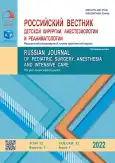Anesthetic management of a repeatedly operated patient with extrahepatic portal hypertension: Сase report
- Authors: Naleev A.A.1, Lazarev V.V.1,2, Linkova T.V.1, Tsypin L.E.1,2
-
Affiliations:
- Pirogov Russian Children’s Clinical Hospital
- Pirogov Russian National Research Medical University
- Issue: Vol 12, No 1 (2022)
- Pages: 93-98
- Section: Case reports
- URL: https://journal-vniispk.ru/2219-4061/article/view/123594
- DOI: https://doi.org/10.17816/psaic1036
- ID: 123594
Cite item
Full Text
Abstract
BACKGROUND: The use of high doses of opioids and general anesthetics can cause unwanted side effects that directly affect the patient's recovery and his psycho-emotional and social well-being. In this regard, the general anesthesia method enables the dose reduction of general anesthetics and opioid analgesics. This is relevant, especially in children with concomitant thrombocytopenia, in whom epidural blockade is contraindicated.
CASE REPORT: This article describes using the alpha-2-adrenergic agonist, dexmedetomidine, for anesthesia in a 16-year-old girl during corrective surgery for extrahepatic portal hypertension after several previous operations. Using the selective alpha-2-adrenergic agonist, dexmedetomidine, for general anesthesia produced effective and stable pain relief intraoperatively and rapid recovery of spontaneous breathing and consciousness after anesthesia. The total dose of intraoperative consumption of fentanyl compared with previously performed anesthesia was less than two times, and sevoflurane by 30%, while maintaining adequate anesthetic protection.
CONCLUSION: During surgical interventions, it is impossible to perform epidural anesthesia in patients with thrombocytopenia with extrahepatic portal hypertension. The centrally acting alpha-2-agonist, dexmedetomidine, may be used to reduce the doses of anesthetics and opioid analgesics used.
Full Text
##article.viewOnOriginalSite##About the authors
Aleksey A. Naleev
Pirogov Russian Children’s Clinical Hospital
Email: dr.naleyev@gmail.com
ORCID iD: 0000-0002-9383-5167
SPIN-code: 3768-9995
Anesthesiologist-Resuscitator
Russian Federation, 117, Leninsky av., Moscow, 119571Vladimir V. Lazarev
Pirogov Russian Children’s Clinical Hospital; Pirogov Russian National Research Medical University
Email: lazarev_vv@inbox.ru
ORCID iD: 0000-0001-8417-3555
SPIN-code: 4414-0677
MD, Dr. Sci. (Med.), Professor, Head of the Department of Pediatric Anesthesiology and Intensive Care therapy Anesthesiologist-Resuscitator
Russian Federation, 117, Leninsky av., Moscow, 119571; МоскваTatiana V. Linkova
Pirogov Russian Children’s Clinical Hospital
Email: linkovat@gmail.com
ORCID iD: 0000-0002-3275-9332
SPIN-code: 5720-4209
MD, Cand. Sci. (Med.), Anesthesiologist-Resuscitator
Russian Federation, 117, Leninsky av., Moscow, 119571Leonid E. Tsypin
Pirogov Russian Children’s Clinical Hospital; Pirogov Russian National Research Medical University
Author for correspondence.
Email: 1dca@mail.ru
ORCID iD: 0000-0002-3114-8759
SPIN-code: 5062-2010
MD, Dr. Sci. (Med.), Professor, Anesthesiologist-Resuscitator
Russian Federation, 117, Leninsky av., Moscow, 119571; MoscowReferences
- Khanna R, Sarin SK. Non-cirrhotic portal hypertension diagnosis and management. J Hepatol. 2014;60(2):421–441. doi: 10.1016/j.jhep.2013.08.013
- Wani ZA, Bhat RA, Bhadoria AS, Maiwall R. Extrahepatic portal vein obstruction and portal vein thrombosis in special situations: Need for a new classification. Saudi J Gastroenterol. 2015;21(3):129–138. doi: 10.4103/1319-3767.157550
- Gugig R, Rosenthal P. Management of portal hypertension in children. World J Gastroenterol. 2012;18(11):1176–1184. doi: 10.3748/wjg.v18.i11.1176
- Vogel CB. Pediatric portal hypertension: A review for primary care. Nurse pract. 2017;42(5):35–42. doi: 10.1097/01.NPR.0000515427.91649.91
- Belskiy VA, Molkov AM, Utkin IA, et al. Anaesthesia protocol to extended liver resections: a paradigm shift under the influence of the experience of liver transplantation (literature review). Annals of HPB Surgery. 2016;21(2):39–51. (In Russ.) doi: 10.16931/995-5464.2016239-51
- Kehlet H, Holte K. Effect of postoperative analgesia on surgical outcome. Br J Anaesth. 2001;87(1):62–72. doi: 10.1093/bja/87.1.62
- Van Dam RM, Hendry PO, Coolsen MM. Initial experience with a multimodalenhanced recovery programme in patients undergoing liver resection. Br J Surg. 2008;95(8):969–975. doi: 10.1002/bjs.6227
- Jacquenod P, Wallon G, Gazon M, et al. Incidence and risk factors of coagulation profile derangement after liver surgery: implications for use of epidural analgesia. Retrospective cohort study. Anaesthesia and Analgesia. 2018;126(4):1142–1147. doi: 10.1213/ANE.0000000000002457
- Peck-Radosaveljevic M. Hypersplenism. Eur J Gastroenterol Hepatol. 2001;13(4):317–323. doi: 10.1097/00042737-200104000-00004
- Khusainova II. Comparative evaluation of methods of anesthesia during operations in gynecologic oncology. Medicine. 2016;(2):16–22. (In Russ.)
- Khomyakov EA, Rybakov EG, Zarodnyuk IV, et al. Risk factors of postoperative prolonged ileus after colorectal cancer surgery. Grekov’s Bulletin of Surgery. 2017;176(5):82–87. (In Russ.) doi: 10.24884/0042-4625-2017-176-5-82-87
- Colvin LA, Bull F, Hales TG. Perioperative opioid analgesia-when is enough too much? A review of opioid-induced tolerance and hyperalgesia. Lancet. 2019;393(10180):1558–1568. doi: 10.1016/S0140-6736(19)30430-1
- Kim HJ, Kim MS, Kim HY, et al. Effect of Timing of Intravenous Fentanyl Administration on the Incidence of Posttonsillectomy Nausea and Vomiting. Laryngoscope. 2020;130(12):2900–2905. doi: 10.1002/lary.28533
- Ayad S, Khanna AK, Iqbal SU, Singla N. Characterisation and monitoring of postoperative respiratory depression: current approaches and future considerations. Br J Anaesth. 2019;123(3):378–391. doi: 10.1016/j.bja.2019.05.044
- Ovezov AM, Panteleeva MV, Knyazev AV, et al. Neurotoxicity of general anesthetics: A modern view of the problem. Neurology, Neuropsychiatry, Psychosomatics. 2015;7(4):78–82. (In Russ.) doi: 10.14412/2074-2711-2015-4-78-82
- Wrigge H, Uhlig U, Zinserling J, et al. The effect of different ventilator settings on pulmonary and systemic inflammatory responses during major surgery. Anaesthesia and Analgesia. 2004;98(3):775–781. doi: 10.1213/01.ane.0000100663.11852.bf
- Ivchenko AP, Kitiashvili DI. Modern aspects of premedication within the concept of fast track surgery. Journal of new medical technologies. 2016;23(1):91–95 (In Russ.) doi: 10.12737/18490
Supplementary files







